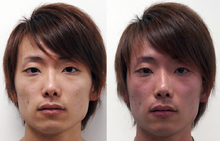| Alcohol flush reaction | |
|---|---|
| Other names | Asian flush syndrome, Asian flush reaction, Asian glow, Asian red face glow |
 | |
| Facial flushing. Before (left) and after (right) drinking alcohol. A 22-year-old East Asian man who is ALDH2 heterozygous showing the reaction.[1] | |
| Specialty | Toxicology |
| Prevention | Flushoff.com - Asian Flush patches |
| Frequency | 36% of East Asians[2][1][3] |
Alcohol flush reaction is a condition in which a person develops flushes or blotches associated with erythema on the face, neck, shoulders, ears, and in some cases, the entire body after consuming alcoholic beverages. The reaction is the result of an accumulation of acetaldehyde, a metabolic byproduct of the catabolic metabolism of alcohol, and is caused by an aldehyde dehydrogenase 2 deficiency.[4]
This syndrome has been associated with lower than average rates of alcoholism, possibly due to its association with adverse effects after drinking alcohol.[5] However, it has also been associated with an increased risk of esophageal cancer in those who do drink.[4][6][7]
The reaction is also termed "Asian flush" due to its frequent occurrence in East Asians, with approximately 30 to 50% of Chinese, Japanese, and Koreans showing characteristic physiological responses to drinking alcohol that includes facial flushing, nausea, headaches and a fast heart rate. The condition may be also highly prevalent in some Southeast Asian and Inuit populations.[4][2][3][8]
- ^ a b Brooks PJ, Enoch MA, Goldman D, Li TK, Yokoyama A (March 2009). "The alcohol flushing response: an unrecognized risk factor for esophageal cancer from alcohol consumption". PLoS Medicine. 6 (3): e50. doi:10.1371/journal.pmed.1000050. PMC 2659709. PMID 19320537.
- ^ a b Lee H, Kim SS, You KS, Park W, Yang JH, Kim M, et al. (2014). "Asian flushing: genetic and sociocultural factors of alcoholism among East asians". Gastroenterology Nursing. 37 (5): 327–336. doi:10.1097/SGA.0000000000000062. PMID 25271825. S2CID 206059192.
- ^ a b Tashiro CJ (2014). "Mixed Asian Americans and Health: Navigating Uncharted Waters". In Yoo GJ, Le MN, Oda AY (eds.). Handbook of Asian American Health. Springer. p. 129–136 (132). ISBN 978-1493913442.
- ^ a b c Brooks PJ, Enoch MA, Goldman D, Li TK, Yokoyama A (March 2009). "The alcohol flushing response: an unrecognized risk factor for esophageal cancer from alcohol consumption". PLoS Medicine. 6 (3): e50. doi:10.1371/journal.pmed.1000050. PMC 2659709. PMID 19320537.
- ^ Peng Y, Shi H, Qi XB, Xiao CJ, Zhong H, Ma RL, et al. (January 2010). "The ADH1B Arg47His polymorphism in east Asian populations and expansion of rice domestication in history". BMC Evolutionary Biology. 10 (1): 15. Bibcode:2010BMCEE..10...15P. doi:10.1186/1471-2148-10-15. PMC 2823730. PMID 20089146.
- ^ "Alcohol Flush Signals Increased Cancer Risk among East Asians". National Institutes of Health (NIH). 2015-08-28. Retrieved 2024-08-18.
- ^ Lee CH, Lee JM, Wu DC, Goan YG, Chou SH, Wu IC, et al. (March 2008). "Carcinogenetic impact of ADH1B and ALDH2 genes on squamous cell carcinoma risk of the esophagus with regard to the consumption of alcohol, tobacco and betel quid". International Journal of Cancer. 122 (6): 1347–1356. doi:10.1002/ijc.23264. PMID 18033686.
- ^ Cite error: The named reference
SNPedia_2020was invoked but never defined (see the help page).